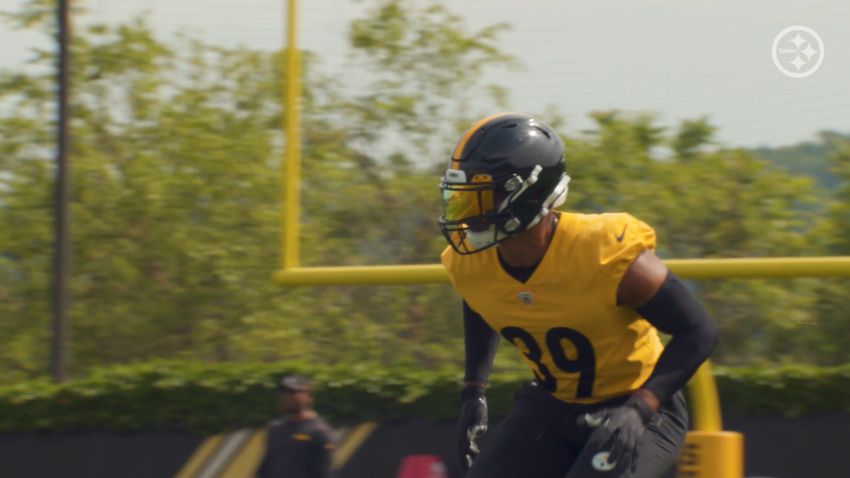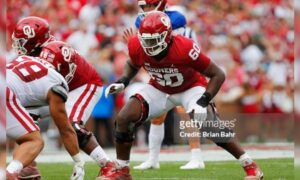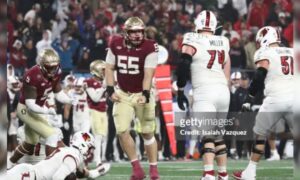Since the acquisition of Minkah Fitzpatrick at the onset of the 2019 season, Keith Butler and Mike Tomlin have crafted one of the most simplistic, yet menacing defensive schemes in the league, relying on creative rush schemes with a top tier front four accompanied with deceptive and schematically sound post snap rotations in the secondary. Whether playing man or zone coverage, the Steelers coaching staff challenges their safeties to play around with their alignments pre snap, making it nearly impossible for the quarterback to gauge what they will end up in post snap. More specifically, quarterbacks league wide discern two high schemes to be “middle of the field open” coverages while designating single high schemes as “middle of the field closed coverages”.
Thus, the Steelers ability to seamlessly transition from pre snap looks into exotic post snap rotations consistently causes quarterbacks to hang onto the football long enough for the talented front four, led by perennial defensive player of the year candidate T.J. Watt, to generate enough pressure to keep opposing offenses behind the chains and force timely turnovers.
While a relatively simplistic defense on early downs, Butler, Tomlin, and company, save their most exotic coverage looks for third and long situations, where the offense is forced to become one dimensional and the Steelers can counter with their Dime package, giving them enough speed and coverage ability to excel in said situations. While Tomlin and Butler certainly deserve more credit than they receive at times for their defensive schematics, it is important to note that the influx of talent in the secondary over the past two seasons aids in the execution of advanced concepts. Nonetheless, today we will be taking a deeper dive into some of the more interesting post snap rotations executed by the Steelers defense during the 2020 season.
Man Coverage Post Snap Rotations
While post snap rotations are generally better understood in zone coverage rotations, the Steelers, a team who plays man coverage at higher rates than almost any other team in the league, try to be equally creative in disguising their man coverage looks. As tight man coverage works to eliminate quick game regardless, confusing the quarterback by toying providing vastly different pre and post snap looks can force him to hold onto the football for even longer, disrupting timing and allowing rushers to get home.
Below on a third and long from a Week 11 matchup against the Jaguars, the Steelers align pre snap with six men crowding the line of scrimmage, with the remaining defensive backs aligned tightly at seven yard depth, suggesting a cover 0, six man pressure.
At the snap, Minkah Fitzpatrick and Terrell Edmunds drop into deep 1/2 zone assignments, with Cam Sutton, Steven Nelson, and Justin Layne assuming man coverage from trail technique with inside leverage. Mike Hilton, aligned at inside linebacker depth, opens to assume man coverage on the #3 receiver to the trips side, while Vince Williams picks up the running back on a hug blitz(also known as a green dog rush). Given that the Jaguars had four comeback routes on in an attempt to attack the sticks, the Steelers ability to counter with Cover 2 man, allowing their man coverage defenders to assume trail technique, serves as a perfect counter, forcing Jake Luton to hold onto the ball for an extra second, allowing Bud Dupree to arrive from his blindside for the sack.
While rotating into Cover 2 man is a Butler and Tomlin staple in third and long situations, third and medium situations, in which opposing offenses have a much wider play sheet, the coaching staff has relied heavily on Cover 1 robber over the past two seasons. On a third and medium of the first drive from a Week 5 blowout victory against the Cleveland Browns, the Steelers provide a Cover 2 man look pre snap, with Minkah and Edmunds aligned at 12 yard depth, five defenders, including the hug blitzing Devin Bush, crowding the line of scrimmage, and the remaining defenders in press alignments to match the Browns 11 personnel.
However, as the Browns motion into trips, Minkah Fitzpatrick slowly creeps down as a robber defender, undercutting a three step slant and taking it back for a touchdown. While Minkah’s disguise could not have been executed more perfectly, Coach Tomlin and Keith Butler deserve credit for identifying both the Browns tendencies on possession downs, as well as an understanding that teams are far more likely to attack the middle of the field on third and manageable situations when presented with a two high, “middle of the field open” look.
While fans watching the game live see Minkah Fitzpatrick, an all world player in his own right, making a spectacular, game changing play, few understand the backroom discussions between coaches and players that take place to allow plays like this one below to manifest themselves in games.
Later in the same game against the Browns, the Steelers once again opt to get creative with a Cover 1 scheme in a third and manageable situation. This time, the Steelers have seven players, including Minkah Fitzpatrick crowding the line of scrimmage, with Joe Haden, Steven Nelson, Mike Hilton, and Terrell Edmunds playing from depth in the secondary, suggesting an seven man pressure scheme with a Cover 3 shell behind it. Nonetheless, at the snap Sutton rotates out to match #3 to the strong side with outside leverage man coverage, as Nelson, Hilton, and Haden simultaneously assume outside leverage in man coverage as well. Minkah Fitzpatrick meanwhile bluffs an A-gap blitz before dropping into a Cover 1 hole zone in the shallow middle of the field, occupying the middle of the field and preventing Baker from hitting his first read in the slant window.
Once again, Baker is forced to hold onto the football longer than anticipated, and the pocket closes down on him, allowing the Steelers to get off the field once again on third down in a game in which they held the Browns to a 1-15 figure on possession downs.
While man coverage is quite literally the simplest defensive scheme that a team can deploy, being that it is Pittsburgh’s most frequently utilized coverage concept, their success in deploying it with such frequency largely depends on their ability to disguise looks by providing exotic pre snap looks. The acquisition of Minkah Fitzpatrick, as well as the versatile play of players like Cam Sutton and Mike Hilton has provided the team with the flexibility to become comfortable not only with playing man coverage at higher frequency, but also trusting their players to vary their alignments pre snap while still being able to execute their assignment at a high level.
While many would argue that the defense declined down the final quarter of the season, it is an understatement to say that an offense’s inability to build early leads and maintain possession of the football hurts a defense’s ability to keep opposing offenses behind the chains, and thus their ability to deploy more exotic coverage looks.
If the Steelers intend on relying on their top tier defense to create stops and force turnovers once again, the offense will need to convert short field opportunities into scores, and help make opposing offenses one dimensional later in games, where the Steelers ferocious pass rush, stingy man coverage, and elite safety play will help produce positive results.
Zone Coverage Post Snap Rotations
As I previously mentioned, man coverage concepts are the Steelers staple in possession down situations, making their occasional choices to throw curveballs with an exotic post snap rotation into zone coverage, usually prepared with an equally exotic stunt up front, deadlier than it has even been during the Keith Butler era. One of my favorite examples from last season comes from an early third and long in a Week 11 matchup against the Jacksonville Jaguars, with the Steelers aligning in a single high, 3-3 stack, before rotating post snap into a traditional Tampa 2 look.
Pre snap, the Steelers align with T.J. Watt, as the only defender with his hand in the dirt, alongside Cam Heyward, Bud Dupree, and Vince Williams crowding the line as stand up rushers. Behind them, Robert Spillane and Avery Williamson align as inside linebackers, with Mike Hilton and Terrell Edmunds as overhang defenders, Joe Haden and Steven Nelson to the boundary, and Minkah Fitzpatrick playing at fifteen yard depth as the post safety. Given their alignment and tendencies, it appears they are likely to play either a Cover 1 or Cover 3 scheme accompanied by a five man pressure up front.
Nevertheless, at the snap, Terrell Edmunds quickly drops to assume a deep ½ zone while Minkah rotates over to assume the other deep ½ zone, meanwhile, Avery Williamson drops deep to assume seam duties as the Tampa backer as both boundary corners gain depth patiently in their flat zones. Up front, Cam Heyward loops outside while a blitzing Vince Williams replaces inside, while T.J. Watt stunts inside, drawing a double team and allowing a blitzing Mike Hilton to come free off the edge on a Nickel blitz.
Thus, as the creative four man rush forces Jake Luton to release the ball instantaneously, he fails to realize that Bud Dupree has dropped out as a hook/curl defender opposite of Robert Spillane, throwing a dangerous pass which Dupree drops for what could have been a walk in, pick six.
This is a perfect example of where Tomlin and Butler are at their best, creating exotic four man pressures that can hit like traditional blitzes while simultaneously dropping unanticipated defenders into coverage to surprise quarterbacks and create takeaway opportunities.
Later in the same game, facing another third and long situation down 20-3, the Jaguars once again predictably try to attack the sticks with three vertical routes and two chips to the flat out of an empty formation. Pre snap, the Steelers have all six defensive backs, aligned at depth with Cam Sutton, Mike Hilton, Justin Layne, and Steven Nelson hovering at ten yard depth while Minkah and Terrell Edmunds align in a two high shell at 15 yards depth. The remaining five defenders, including dime backer Marcus Allen, align crowded at the line of scrimmage. At the snap, four defenders rush while Marcus Allen drops out to the flat opposite of Cam Sutton, while both boundary cornerbacks drop into deep ⅓ zone assignments.
Mike Hilton, who was aligned as a Tampa 2 backer, rotates to assume a deep 1/3 zone as the post safety while Minkah Fitzpatrick and Terrell Edmunds stand at the sticks with deep hook/curl responsibilities. Sitting in place with his eyes locked on Jake Luton, Edmunds is able to easily undercut the post route at the sticks to tip the ball up in the air and come down with it for his second interception of the game, and just the third of his career.
While it is certainly one of the Steelers favorite post snap rotations, this variation for third and long, in which the safeties are able to sit in place at the sticks and observe everything in front of them, is a smart winkle which helped produce a game sealing turnover.
While the Steelers are no longer the fire zone reliant team which they had become synonymous with throughout the entire Dick Lebeau tenure and the early portion of Keith Butler’s reign in Pittsburgh, their ability to maintain exotic zone concepts working in tandem with their stingy man coverage helps wreak havoc on opposing offenses. Post snap rotations, and the overall success of the Dime package were a large reason why the Steelers defense finished comfortably within the top ten in third down efficiency this past season. Moving ahead to 2021, it will be interesting to see who out of Antoine Brooks Jr, James Pierre, Shakur Brown, and Tre Norwood, among others, steps up to assume a role in the teams vaunted Dime package, where they will be tasked with furthering the success of a unit which has flourished over the past two seasons.








